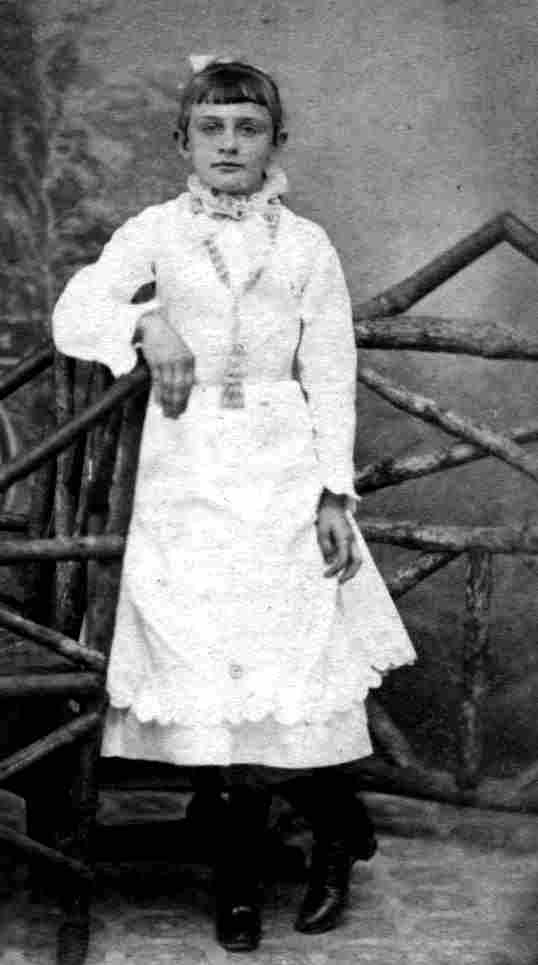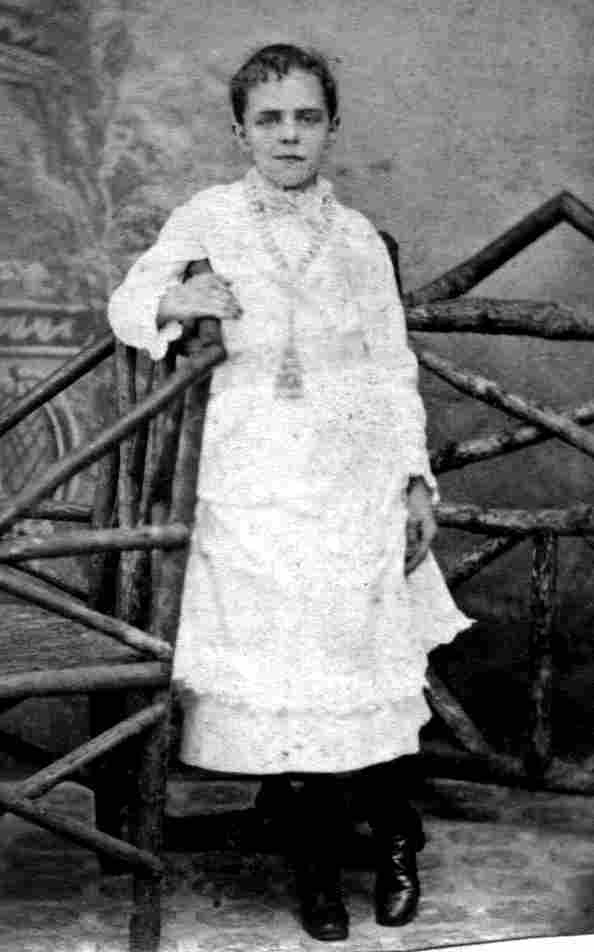
Coordinated Family Outfits: Fraternal Twins--Dresses

Figure 1.--This girl, Addie, looks to have been photographed in the early 1880s, but this is only a HBC preliminary assessment. She wears a dress much like a smock as there is a white skirt underneath. Note that her twin brother wears the exact same outfit down to the high ruffled collar. The only difference HBC can discern is that Addie wears a hair bow. Interestingly, hair bows are unsual on such short hair.
|
Today it is most commom to dress frateranal brother/sister twins in boyish styled clothing when dressing them alike. In the 19th and early 20th century, girls did not wear boys' fashions as they do now. In fact, when dressing twins alike it was common to outfit them in dresses. This was a reflection of the time as younger boys in the 19th cerntury common wore dresses just like those of their sisters. Sometimes the children look just alike, but we know that they are fraternal twins are they wouldn't be different genders.
Chronology
HBC does not yet have sufficient information and images to build a reasonable time-line chromolgy. HBC is fairly confident that dressing older twins alike was more common in the late 19th than the early 20th century, but chronolgical data is lacking. This is an area that HBC hopes to pursue.
Ages
It was the younger boys of course that were most likely to be outfitted in dresses matching their sisters. Slightly older boys might wear kilt suits rather than dresses. Girls did not commonly wear klit suits so mothers who elected matching outfits has to keep their sons in dresses. It was common gor boys to wear dresses throughout the 19th century. Commonly boys would be breeched at about 5 years of age, buth this varied widekly from family to family. Some boys were breeched earlier and some later. Often a boy's size was an important consideration. Boys of 6 and 7 might continue tomwear dresses, although by age 8 it was much less common. Even so some boys were kept in dresses even longer. Ater the turn of the century the practice continued, but for increasinly younger boys.
Styles
Most mother who chose to dress their franteral twins identically often chose plainer dresses. On this page a set of twins, Addie and Albert, wear very plain smock-like dresses over a skirt. There is very little trim or embelishment. The only exception is a very involved high rufflede collar and a pendant of some kind. The ruffled collar is particularly interesting. It seems rather out of place on such a otherwise plain smock.
Colors
White was a popular color for twin dress outfits. HBC does not have much color information, but the available photographic record shows that white was a common choice.
Hair Styles
Some mothers selecting identical outdits for their twins also styled their hair identically. In some cases small differences were added such as a hair bow for the girl. One of the problems with hair styles is that if a particularly girlish hair style is selected, the children look like sisters and may not be noted. In many old photographs, the children are not identified.
Conventions
A number of questions arise concerning the tendency to dress twins alike in dresses. HBC hopes to pursue these questions by reviewing some of the many 19th century magazines offering household advise.

Figure 2.--Albert's outfit is exactly like his twin sister's in every detail. Notice the slight difference in their poses--the right hands are held differently.
|
Addie and Albert
A HBC contributor wonders if this was Albert's normal attire or was this a special picture. This relates to a question HBC has posed elsewhere and is as yet unable to answer. Was a boy breeched all at one time or did he continue to wear out his dresses before having them replaced. Actual data is at this time unavailable. HBC believes, however, that once breeched, mothers even in the 19th century might have difficultly outfiting their sons in dresses for portraits and other special occasions. These children look fairly old perhaps 8 or 9 years of age. The children here appear to be wearing smocks--but with dresses underneath. Notice the scalloping detailing at the hem of the smock which is repeated in similar wrist trim. I'm not sure what the collar is attached to. Note that everything was identical--even the shoes and pose. (HBC has not yet extensively addressed shoes. Shoes for children may have been sdimilar for both genders. Of course adult shoes were quite common.) The basic difference with Addie and Albert is the hair. Addie has a slightly longer cut and wears bangs and a hair bow--Albert does not.
HBC notes an unidentified American family. There are three children. The two oldest children look to be fratenal twins. They both wear identical dresses. We believe that they are boy and grl fraternal twinns because if they were girls almost ceratinly their hair would have been done the same. It is unlikely that twin girls wearing identical dresses would have different hair styles. Note the dresses are a plaid-like material. Note that the twins also have identical dolls. They appear to have a younger sister, but HBC is not positive about this.
Christopher Wagner

Navigate the Boys' Historical Clothing Web Site:
[Return to the Main fraternal twin page]
[Introduction]
[Activities]
[Bibliographies]
[Biographies]
[Chronology]
[Clothing styles]
[Countries]
[Fashion images]
[Contributions]
[FAQs]
[Glossaries]
[Satellite sites]
[Boys' Clothing Home]
Created: September 12, 2000
Last updated: February 9, 2002




